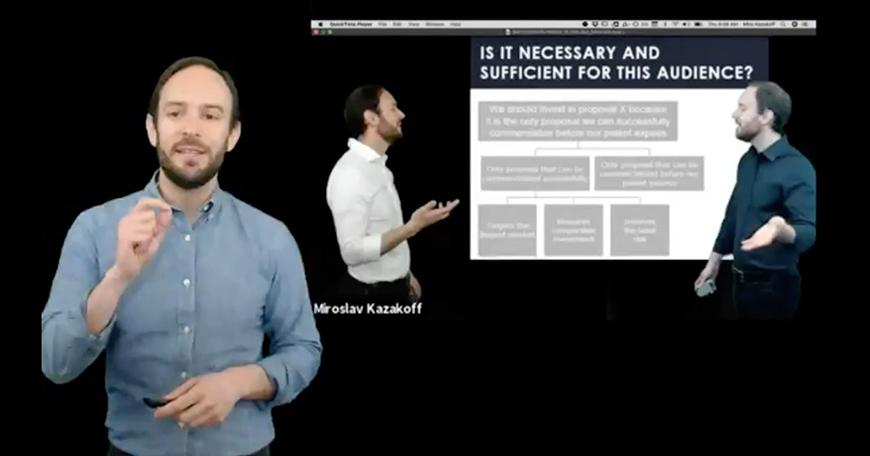Teaching Remotely: Environment, Participation & Innovative Techniques

Remote learning poses unique challenges, particularly with student engagement and participation. Professor Miro Kazakoff, who teaches 15.286 (Communicating with Data) at Sloan, shared strategies he used and insights from the spring 2020 semester around environment, participation, and unique “tricks” he used in class.
Environment
When viewing Kazakoff’s virtual classes, he can be seen standing in front of a completely black background with slides in the same frame. This “black void”, as he calls it, is effective for eliminating distraction caused by video backgrounds, and it feels more akin to in-person instruction when his students see him standing next to his slides. Kazakoff also prefers to use a physical whiteboard, as it most closely replicates him writing on the board in a classroom. Another challenge associated with the remote learning environment is the ease with which students can click away from the class session while appearing attentive. To combat this, Kazakoff found the importance of frequent engagement activities to make sure students are staying focused on the class as much as possible and not clicking away.
Participation
Like many other instructors, Kazakoff experienced decreased participation during remote learning. He leaned more heavily on cold calling as a result, with the help of his TAs who have a pre-made class list for greater efficiency in calling on students. His students reported that they actually liked the ease of being cold called and the forced engagement, even if they may not have always appreciated it in the moment. Kazakoff also used breakout rooms more frequently, and found that it can be helpful to consider choosing a conversation facilitator in each room. Additionally, he shifted to more of a peer feedback model because of the nature of his communications class; to help with peer feedback, Kazakoff placed students in consistent groups of 5-7 people for class activities and presentations where students receive peer feedback. Though he usually likes to mix up groups and have students from different departments work together, the consistent groups created a sense of community for students and allowed them to see familiar faces during these times.
Tricks
“Tricks” are cool or interesting ways that Kazakoff used to deliver material to keep students engaged. For example, Kazakoff used the same video intro to begin each class, complete with animations and background music. Other “tricks” included the class lecture where students saw a video of him arguing with himself, and a particularly popular trick where he walked off the screen into a graph on the slides.
By demonstrating how they are investing time in innovative approaches to remote teaching, instructors can inspire students to also put forth a similar level of effort and quality of feedback to each other. However, Kazakoff also has ambivalence about using tricks to keep students engaged and excited about class, but given that remote pedagogy is a new and evolving challenge, there is value in experimenting with innovative approaches.
Remote learning is difficult for students and instructors alike, but nevertheless the strategies described above show potential for making the remote learning experience effective and meaningful.
Melissa Cao, Teaching and Learning Content Writer

